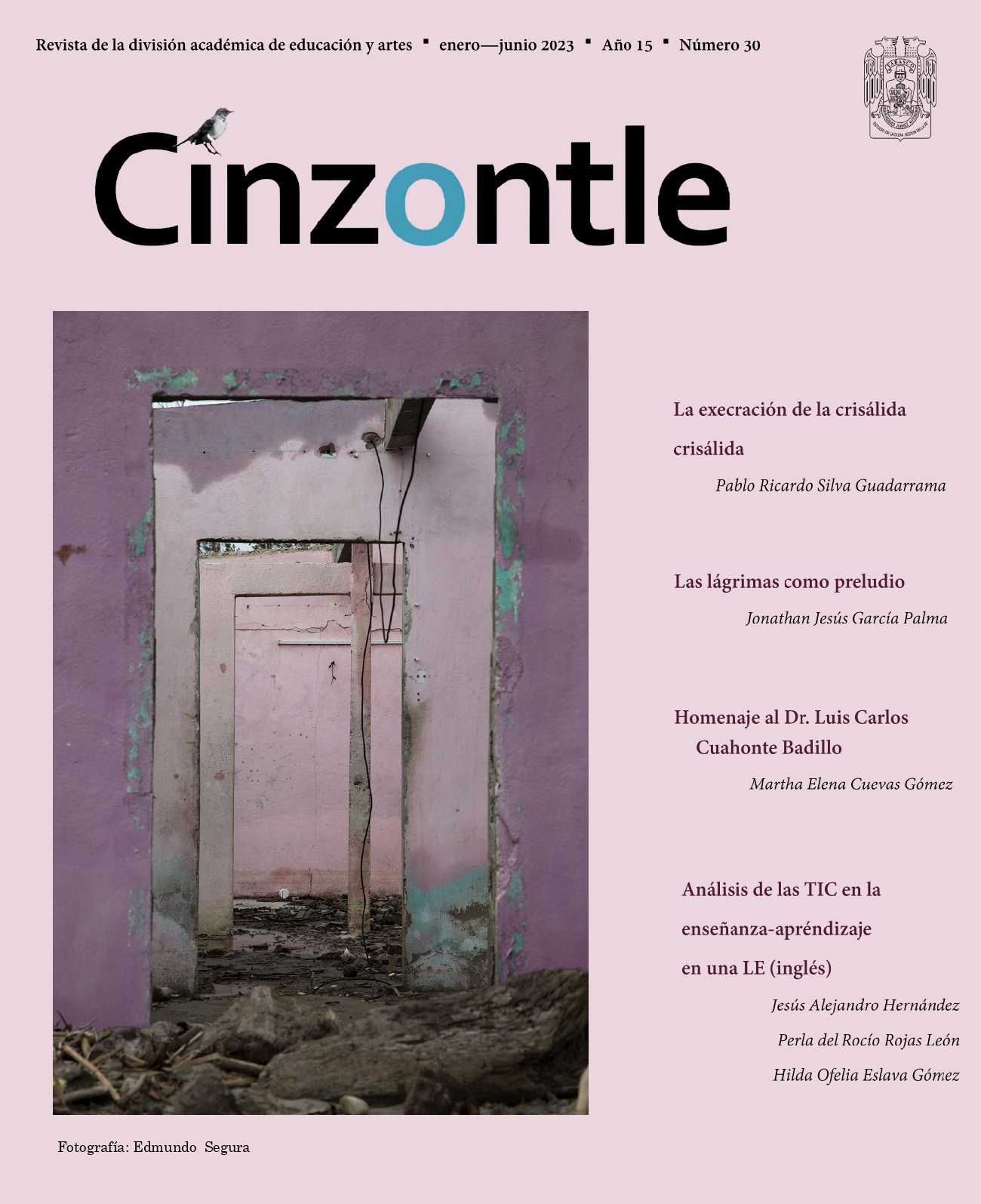Analysis of ICT in teaching-learning in a foreign language (english)
DOI:
https://doi.org/10.19136/Cz5085x23Keywords:
learning, education and technology, language teaching, Information TechnologyAbstract
ABSTRACT
Globalization, technological development and pedagogical innovation are the main points of which teachers and students are subject to the learning and teaching of a second language (L2), in this case English. For this reason, ICT (Information and Communication Technologies) are an innovative support for both teaching for the teacher and for student learning, where classes can be made interesting and entertaining with these elements. English is in a privileged position in the world, since it is inherent to global technological evolution, which means that its learning is a tool for job, academic and economic success. Thus, this article addresses a documentary analysis about the processes and handling of ICT in the teaching-learning of an L2, highlighting the advantages and disadvantages of its application in the classroom. It is concluded that ICTs are a complementary tool, as Cruz refers (cited in Peralta, 2008), which, although they do not necessarily replace a face-to-face class, can enrich teaching methods, adapting to contemporaneity and also to the students, as long as the necessary elements exist for its implementation.
References
Borromeo, C. (2016). REDES SOCIALES PARA LA ENSEÑANZA DE IDIOMAS: EL CASO DE LOS PROFESORES. PIXEL-BIT. REVISTAS DE MEDIOS Y EDUCACIÓN, (48), 41-50. RECUPERADO DE https://www.redalyc.org/pdf/368/36843409004.pdf
Cortés, J. (2012). LAS TICS EN EL AULA DE LENGUA EXTRANJERA. (TRABAJO DE FIN DE GRADO). UNIVERSIDAD DE ALMERÍA, ESPAÑA, RECUPERADO DE http://repositorio.ual.es/bitstream/handle/10835/1979/858.pdf;jsessionid=43 BBA45D9F2758A9BD766999706E24B2?sequence=1
De la Torre, S., Carranza, A., Islas, C. y Moreno, H. (2009). EL ROL DE LOS ALUMNOS ANTE EL USO DE LAS TIC´S EN EL PROCESO DE LA ENSEÑANZA APRENDIZAJE. UNIVERSIDAD DE GUADALAJARA. RECUPERADO DE http://repositorio.cualtos.udg.mx:8080/jspui/bitstream/123456789/315/1/El%
Rol%20de%20los%20alumnos%20ante%20el%20uso%20de%20las%20 TIC%60s.pdf
Díaz, D. (2013). TIC EN EDUCACIÓN SUPERIOR: VENTAJAS Y DESVENTAJAS. REVISTA EDUCACIÓN Y TECNOLOGÍA, (4), 44-50. RECUPERADO DER file:///C:/Users/victor/Downloads/DialnetTICEnEducacionSuperior5072156%20(1).pdf
Gutiérrez, N., Herrera, S. y Pérez, Y. (2017). LAS TIC EN LA ENSEÑANZA DEL INGLÉS EN EDUCACIÓN BÁSICA. REVISTA ELECTRÓNICA SOBRE TECNOLOGÍA, EDUCACIÓN Y SOCIEDAD, 4, (7), 861-882. RECUPERADO DE https://www.ctes.org.mx/index.php/ctes/article/download/655/739/2637
Krashen, S. (1982). PRINCIPLES AND PRACTICE IN SECOND LANGUAGE ACQUISITION. PRENTICE-HALL. RECUPERADO DE http://www.sdkrashen.com/content/books/principles_and_practice.pdf
Lightbown, P. y Spada, N. (2013). HOW LANGUAGES ARE LEARNED. FOURTH EDITION. UNITED KINGDOM. OXFORD. RECUPERADO DE https://www.saint david.net/uploads/1/0/4/3/10434103/how_languages_are_learned.pdf
Lizasoain, A., Ortiz, A. y Becchi, C. (2018). UTILIZACIÓN DE UNA HERRAMIENTA TIC PARA LA ENSEÑANZA DEL INGLÉS EN UN CONTEXTO RURAL. EDUC. PESQUI, (44), 1-22. Doi: http://dx.doi.org/10.1590/s1678-4634201844167454
Mayer, R. (2005). THE CAMBRIDGE HANDBOOK OF MULTIMEDIA LEARNING. NEW YORK: CAMBRIDGE UNIVERSITY PRESS.
Morchio, M. (2014). EL ROL DE LAS TIC EN LA CLASE DE INGLÉS. EN EL CONGRESO IBEROAMERICANO DE CIENCIA, TECNOLOGÍA, INNOVACIÓN Y EDUCACIÓN. BUENOS AIRES, ARGENTINA. RECUPERADO DE https://www.ctes.org.mx/index.php/ctes/article/view/655
Peralta, C. (2008). EL PAPEL DE LAS TIC EN EL ÁMBITO DE LA ENSEÑANZA DE ELE. EN ACTAS DEL V SIMPOSIO INTERNACIONAL JOSÉ CARLOS LISBOA DE DIDÁCTICA DEL ESPAÑOL COMO LENGUA EXTRANJERA DEL INSTITUTO CERVANTES DE RIO DE JANEIRO (2008). RECUPERADO DE https://cvc.cervantes.es/ensenanza/biblioteca_ele/publicaciones_centros/rio
_2008.htm
Pinto, A., Sánchez, M., García, F. y Cabezas, M. (2017). LA MODALIDAD SEMIPRESENCIAL Y LA PRONUNCIACION DE LA LENGUA INGLESA: RESULTADOS DE UN MODELO APOYADO CON TIC. RED. REVISTA DE EDUCACION A DISTANCIA. 4 (52), 1-28 Doi: http://dx.doi.org/10.6018/red/52/4
Ruiz, F. (2014). VENTAJAS DEL USO DE LAS TIC PARA LA ENSEÑANZA DE LENGUAS EXTRANJERAS. ADVANTAGES OF ICT TO TEACH FOREIGN LANGUAGES. (Trabajo de fin de grado). Universidad de Cantabria, España. Recuperado de https://repositorio.unican.es/xmlui/bitstream/handle/10902/5065/RuizGarcia
Fernando.pdf?sequence=1
Talaván, N. (2012). JUSTIFICACIÓN TEÓRICO-PRÁCTICA DEL USO DE LOS SUBTÍTULOS EN LA ENSEÑANZA-APRENDIZAJE DE LENGUAS EXTRANJERA, TRANS. REVISTA DE TRADUCTOLOGÍA, 16, 23-37. RECUPERADO DE: http://www.trans.uma.es/trans_16/Trans16_023-037.pdf
Torres, M. y Yépez, D. (2018). APRENDIZAJE COOPERATIVO Y TIC Y SU IMPACTO EN LA ADQUISICIÓN DEL IDIOMA INGLÉS. REVISTA MEXICANA DE INVESTIGACIÓN EDUCATIVA, 23(78), 861-882. RECUPERADO DE. http://www.scielo.org.mx/pdf/rmie/v23n78/1405-6666-rmie-23-78-861.pdf


